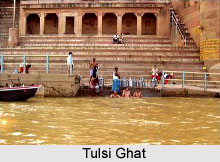 Tulsi Ghat situated in Varanasi is a famous pilgrimage centre. It is also known as Lolark Ghat. The ghat has been named after the famous Hindu poet of the 16th century, Tulsidas. The poet is credited with composing the famous scholarly religious work Ramcharitmanas at Varanasi. It is regarded as a great Indian epic. The poet spent many years in this holy ghat. It is said that Tulsidas got motivated by the pristine Lord Rama temple located at the bank of the Ganga River.
Tulsi Ghat situated in Varanasi is a famous pilgrimage centre. It is also known as Lolark Ghat. The ghat has been named after the famous Hindu poet of the 16th century, Tulsidas. The poet is credited with composing the famous scholarly religious work Ramcharitmanas at Varanasi. It is regarded as a great Indian epic. The poet spent many years in this holy ghat. It is said that Tulsidas got motivated by the pristine Lord Rama temple located at the bank of the Ganga River.
Tulsi Ghat is associated with an ancient mythology. According to this when the manuscript of Tulsidas fell into the River Ganga it did not sink and kept floating instead. However, it is also believed that the Ramlila i.e. story of Lord Rama`s life was staged here for the first time. In order to mark this event a temple of Lord Rama was built on the Tulsi Ghat. Many of the relics of Tulsidas are preserved at the Tulsi Ghat. The house where Tulsidas died, his samadhi, wooden clogs, pillow and the idol of Lord Hanuman which Tulsi worshipped have been well preserved till today.
Tulsi Ghat was earlier known as Lolark Ghat as has been mentioned in Gaharwa Danpatra and Girvanapadamanjari. The holy ghat was cemented and made concrete by the famous industrialist, Baldeo Das Birla in the year 1941.
Here several activities take place like the bath of Lolarkkunda. It is believed that by bathing here one would be blessed with children. Devotees also bath here for the long life of their children. Many pilgrims visiting Varanasi bathe here with the belief that by taking a dip in the holy water of the Ghat one inflicted with leprosy would get rid of the disease. Further, the place where Tulsidas attained salvation is also frequently visited by travellers.
Several cultural activities are also held at this place. For instance during Hindu lunar month of Kartika, i.e. during the months of October and November Krishna Lila is staged here with great enthusiasm and devotion. Apart from this the Ram Lila is also celebrated here with same vigour. People gather in large number to be a part of these celebrations.



















